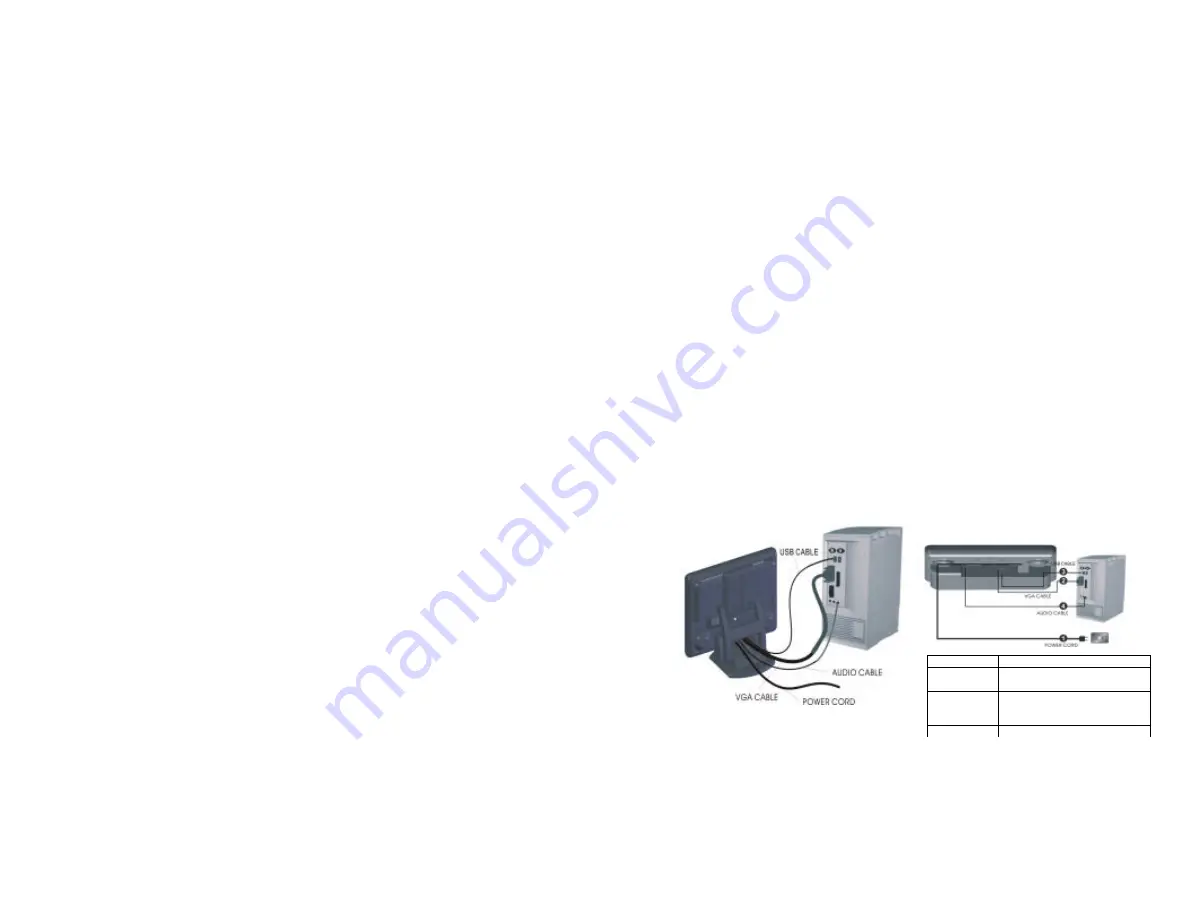
2
System Requirements
The following are basic requirements for using the Touch Monitor. Please check the specifications and
Supported Video Timing
section of this Users Guide for specifics.
•
This touch monitor requires connection to a personal computer. Both industry standard
architecture and Macintosh hardware is supported.
•
Various Operating System versions are supported for touch input operation. Please check
the product features and specifications to insure that the OS you intend to use is supported.
The included software installation disc contains the proper drivers for supported Operating
Systems and devices.
•
An analog, VESA standard video card for the PC is required. This touch monitor complies
with DPMS and Plug & Play (DDC) standards.
•
The personal computer will require either a standard 9 pin serial COM port or USB port,
depending on the product version of the touch monitor. If the serial COM port is a 25 pin,
D-connector, then an adaptor to 9-pin male is required. In addition, consideration should be
given to system IRQ assignments for serial operation, as the touch controller cannot share an
IRQ.
•
There should be enough electrical outlets to support the system installation. This would
include the calculation of total current requirements. Although not a strict requirement, a
surge protected power source is recommended.
Mounting
The Touch Monitor may be used on any work surface by placing it on its supplied stand.
In addition, this product is provided with permanent mounting capabilities. The rear of the main display
body has mounting holes configured to conform to the VESA mounting standard. Typically, this
mounting pattern allows the Touch Monitor to be installed on movable arms and specialized mobile
equipment.
Alternatively, there are slotted mounting holes on the bottom of the product pedestal which will facilitate
permanent installation of this product to walls, countertops and custom installations. Typically, this
mounting pattern is used to attach the Touch Monitor to a counter in a permanent position. This
mounting scheme may provide the most secure and stable mounting environment.
Using any mounting method, consideration should be given to placement relative to cable length, power
sources and cable routing.
Using Touch Input
The surface of this LCD Touch Monitor is a touch sensor. Some degree of caution is required to insure
the effectiveness and long life as an input device. Avoid using sharp objects such as pens, pencils,
scissors or screwdrivers as a pointing stylus. After installation of the driver software, a calibration should
be performed. This action insures that the graphic coordinates match the touch coordinates, sometimes
called mapping.
Different software applications may require speci fic “mouse click” parameters. The touch control panel
will allow selection of multiple types of mouse button actions.
3
INSTALLING THE TOUCH MONITOR
l
DO NOT
install the monitor in areas where sudden temperature changes may occur, or in humid,
dusty, or smoky environments as it may cause fire, electric shock or damage.
l
DO NOT
expose this product to rain, water, moisture, or sunlight
l
MAINTAIN
good ventilation; covering of ventilation slots or holes may cause a fire
l
PLACE
the monitor at least 4” (or 10 cm) way from the walls
l
SAFE
storage temperature of the LCD Touch Monitor is in a range of -20 to +65
l
INSTALL
the software drivers via the supplied CD following standard operating system procedures
NOTE
Remember that the connection of USB devices is done after the software drivers are
loaded. Further instructions are provided during software installat ion and through the
Help files on the driver CD.
Connecting the Monitor
1.
Turn off the PC and the LCD Touch Monitor before making any connections.
2.
Use the supplied VGA cable to connect the VGA connector of the LCD Touch Monitor to the VGA
port of the PC system.
3.
Use the supplied audio cable to connect the “Audio in” jack on your LCD Touch Monitor and the
PC sound card’s “Audio out ” or speaker jack.
4.
Connect the male end of the power cord into a wall socket and the female end to the Touch Monitor.
5.
If your Touch Monitor has a USB interface, use the supplied USB cable to connect the USB
connector of LCD Touch Monitor to the USB port of the PC system. Remember to follow proper
software driver installation.
6.
If your Touch Monitor has a RS232 serial interface, unplug the PC keyboard and reconnect it to the
supplied serial cable power adaptor. Connect the other end of the adaptor to the keyboard
connector on the PC. Connect the serial D-connector to and standard PC serial comport.
Connect the other end or the serial interface cable to the Touch Monitor.
7.
Turn on your computer, and then turn on your LCD Touch Monitor.
u
Power
Plug the power cord in.
v
Input 1
Connect with detachable VGA
cable.
w
Input 2
(Touch
Function)
Connect to USB/RS232 cable
x
Audio In
Connect with PC sound card.
NOTE
For added protection, it is recommended to use a Surge Protection device plugged
between the AC Adapter and the electrical wall outlet to prevent the effects of sudden
current variations from reaching the LCD Touch Monitor. Sudden peaks of electricity may
cause damage to the Monitor.









